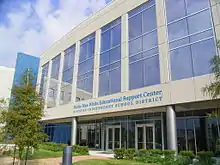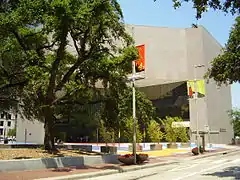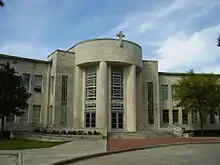Education in Houston
This article is intended to give an overview of the education in Houston.
Healthcare and scientific research
Houston is the seat of the internationally renowned Texas Medical Center, which contains the world's largest concentration of research and healthcare institutions.[1] All 47 member institutions of the Texas Medical Center are non-profit organizations. They provide patient and preventive care, research, education, and local, national, and international community well-being. Employing more than 73,600 people, institutions at the medical center include 13 hospitals and two specialty institutions, two medical schools, four nursing schools, and schools of dentistry, public health, pharmacy, and virtually all health-related careers. It is where one of the first—and still the largest—air emergency service, Life Flight, was created, and a very successful inter-institutional transplant program was developed. More heart surgeries are performed at the Texas Medical Center than anywhere else in the world.[2]
Some of the academic and research health institutions at the center include MD Anderson Cancer Center, Baylor College of Medicine, UT Health Science Center, Memorial Hermann Hospital, The Methodist Hospital, Texas Children's Hospital, and University of Houston College of Pharmacy. The Baylor College of Medicine has annually been considered within the top ten medical schools in the nation; likewise, the MD Anderson Cancer Center has consistently ranked as one of the top two U.S. hospitals specializing in cancer care by U.S. News & World Report since 1990.[3][4] The Menninger Clinic, a renowned psychiatric treatment center, is affiliated with Baylor College of Medicine and The Methodist Hospital System.[5] With hospital locations nationwide and headquarters in Houston, the Triumph Healthcare hospital system is the third largest long term acute care provider nationally.[6]
Higher education
Four separate and distinct state universities are located in Houston. The University of Houston is a nationally recognized Tier One research university and is the flagship institution of the University of Houston System.[7][8][9] The third-largest university in Texas, the University of Houston has nearly 44,000 students on its 667-acre campus in southeast Houston.[10] The University of Houston–Clear Lake and the University of Houston–Downtown are stand-alone universities; they are not branch campuses of the University of Houston. Located in the historic community of Third Ward is Texas Southern University, one of the largest and most comprehensive historically black institutions in the United States.
The University of Houston System's annual impact on the Houston-area's economy equates to that of a major corporation: $1.1 billion in new funds attracted annually to the Houston area, $3.13 billion in total economic benefit, and 24,000 local jobs generated.[11][12] This is in addition to the 12,500 new graduates the UH System produces every year who enter the workforce in Houston and throughout Texas. These degree-holders tend to stay in Houston. After five years, 80.5 percent of graduates are still living and working in the region.[12]
Several private institutions of higher learning—ranging from liberal arts colleges to a nationally recognized research university—are located within the city. Most notably, Rice University, which is one of the leading teaching and research universities in the United States and consistently ranks in the top 20 of best overall universities by U.S. News & World Report.[13]
Three community college districts exist with campuses in and around Houston. The Houston Community College System serves most of Houston. The northwestern through northeastern parts of the city are served by various campuses of the Lone Star College System, while the southeastern portion of Houston is served by San Jacinto College, and portions in the northeast are served by Lee College.[14] The Houston Community College and Lone Star College systems are within the 10 largest institutions of higher learning in the United States.
Primary and secondary education
A 2007 Money survey stated that 91.1% of the students attending schools within the city limits go to public schools and 8.9 percent go to private schools.[15]
Public schools



All public school systems in Texas are administered by the Texas Education Agency (TEA). As of 2018 24 school districts serve different sections of the city of Houston.[16] The largest school district serving the city limits is the Houston Independent School District (HISD), which serves a large majority of the area within the city limits.[17] A portion of west Houston falls under the Spring Branch and Alief independent school districts. Aldine takes parts of northern Houston. Parts of Pasadena, Clear Creek, Conroe, Crosby, Cypress-Fairbanks, Fort Bend, Galena Park, Huffman, Humble, Katy, Klein, New Caney, Sheldon, and Spring independent school districts also take students from the city limits of Houston or otherwise cover parts of the Houston city limits.[18]
The North Forest Independent School District served portions of Houston until its July 1, 2013 closure, when it was absorbed by Houston ISD.[19]
There are also many charter schools that are run separately from school districts, but are administered by the Texas Education Agency. In addition, public school districts—such as Houston ISD and Spring Branch ISD—also have their own charter schools.
State-chartered charter schools
Since 1995 the state of Texas allowed the formation of charter schools.[20] Some charter schools are overseen by traditional school districts while others only have oversight by the State of Texas.
In 2003 charter schools in the Houston area had a combined total of 15,428 students.[21] In 2006, over 25% of charter schools in Texas were located in Greater Houston.[22] In 2006, Todd Ziebarth, a researcher of the National Alliance for Public Charter Schools, said that charter schools may have as many as 15% of the market share of students in Greater Houston. During that year Houston Independent School District (HISD) officials estimated that 12,000 to 13,000 pupils living within the HISD boundaries attend state charter schools. In 2006 around 10,000 students attended HISD-affiliated charter schools.[20]
In 2015 there were over 125 charter school campuses in the area.[23] As of 2017 KIPP Houston had 12,100 students,[24] Harmony Public Schools's Houston-area campuses had 11,000 students,[25] Yes Prep had 9,500 students, Houston Gateway Academy had about 1,900 students, Promise Community School had about 1,700 students, The Varnett School had about 1,700 students, and Excel Academy had 500 students.[24]
History of public education
In the Jim Crow era African-Americans had inferior K-12 educational conditions, with fewer resources in general and less financial support from the state government and from local governments, compared to other races. Teachers of black African origin had, on average, around 70% of the pay of a white teacher, and black students had fewer teachers per capita compared to white and other race peers.[26]
Private schools
Houston has numerous private schools of all types, including non-sectarian, Jewish, Roman Catholic, Greek Orthodox, Protestant, and Muslim. The Texas Education Agency has no authority over private school operations; private schools may or may not be accredited, and achievement tests are not required for private school graduating seniors. Many private schools will obtain accreditation and perform achievement tests as a means of demonstrating that the school is genuinely interested in educational performance. The Houston area is home to more than 300 private schools and several are well-known. Many of the schools are accredited by an accrediting agency recognized by Texas Private School Accreditation Commission (TEPSAC). In addition, Houston area Catholic schools are operated by the Archdiocese of Galveston-Houston.
- Annunciation Orthodox School
- Archway Academy
- Awty International School (serves as the French international school)
- British School of Houston
- The Emery/Weiner School
- The Kinkaid School
- The Monarch School
- St. Pius X High School
- The Regis School (all-boys)
- Saint Agnes Academy (all-girls)
- Strake Jesuit College Preparatory (all-boys)
- St. Catherine's Montessori School
- St. John's School
- Duchesne Academy of the Sacred Heart (all-girls)
- St. Thomas High School (all-boys)
Around 1993 increasing numbers of parents in Greater Houston sent their children to private schools. Dick Ekdahl, the executive director of the Independent Schools Association of the Southwest (ISAS), said that a more robust economy, a negative perception of public schools, and increased interest in religious education caused enrollment at private schools to increase. Stephanie Asin of the Houston Chronicle said "[t]here is no central authority over private schools so collecting enrollment statistics is difficult."[27] She added "local headmasters indicate that enrollment is increasing in their schools and believe that holds true throughout the state's estimated 750 private schools."[27] In 1988, the 35 schools of ISAS had a combined enrollment of 16,895. In 1992 the same 35 schools had a combined enrollment of 18,504.[27]
Homeschooling
The greater Houston area is home to a large homeschooling community with an estimated 40 to 50 thousand homeschooled students, based on 300,000 homeschool students in Texas[28] and 2.04 million in the U.S.[29] Over 100 organizations, support groups, and co-ops provide classes and resources for homeschool families.[30]
Libraries
Public libraries

Residents of Houston are served by the Houston Public Library and the Harris County Public Library. The Houston Public Library has 36 branches throughout the city, plus the Central Library, located Downtown. The Harris County Public Library has 26 branches (3 of them in Houston), primarily serving areas outside the city limits of Houston.
University of Houston, Texas Southern University, Rice University, and Houston Baptist University also have university libraries.
Private libraries
There is one Japanese-language library in Houston, the Sansui-Kai Center Library (三水会センター・図書館).[31]
The Italian Cultural and Community Center has a library in its Logue House (Milford House) offices.[32]
Miscellaneous education
The Japanese Language Supplementary School of Houston, a supplementary Japanese school, is located in the city. Its classes are held at the Westchester Academy for International Studies.[33] The school is for children between ages 5 and 18 who are Japanese speakers.[34] Many of the students are temporarily residing in the United States.[35]
See also
References
- "Texas Medical Center – Largest Medical Center (Video HD (English))". Texas Medical Center. Archived from the original on June 23, 2010. Retrieved March 28, 2009.
- "Texas Medical Center". visithoustontexas.com. Archived from the original on February 8, 2007. Retrieved February 6, 2007.
- "Institutional Profile". mdanderson.org. Archived from the original on March 3, 2009. Retrieved 2007-02-21.
- "Rice and Baylor College of Medicine extend MOU". Rice University, News & Media. Archived from the original on January 18, 2012. Retrieved October 11, 2009.
- "Quick Facts About The Menninger Clinic". menningerclinic.com, The Menninger Clinic. Retrieved March 27, 2009.
- "Archived copy". Archived from the original on October 11, 2011. Retrieved November 4, 2011.CS1 maint: archived copy as title (link)
- Bonnin, Richard. "Carnegie Foundation Gives University of Houston its Highest Classification for Research Success, Elevating UH to Tier One Status". University of Houston. Retrieved February 8, 2011.
- "UH achieves Tier One status in research". Houston Business Journal. January 21, 2011. Retrieved July 6, 2011.
- "UH takes big step up to Tier One status". Houston Chronicle. Retrieved July 6, 2011.
- Khator, Renu (October 4, 2011). "State of the University: Fall 2011" (PDF). University of Houston. Archived from the original (PDF) on October 27, 2011. Retrieved October 5, 2011.
- TRESAUGUE, Matthew (May 17, 2006). "Study suggests UH degrees are crucial economic factor". Houston Chronicle. Retrieved May 31, 2011.
- "The Economic Impact of Higher Education on Houston: A Case Study of the University of Houston System" (PDF). University of Houston System. Archived from the original (PDF) on July 20, 2011. Retrieved 2011-05-14.
- "Rice University, Best Colleges 2009". U.S. News & World Report. Archived from the original on February 16, 2009. Retrieved 2009-03-27.
- "About Lee College." Lee College. Retrieved on May 6, 2013.
- "CITY STATS Houston, TX 2007." Money.
- "City of Houston Annexation FAQ". City of Houston. October 31, 1996. Archived from the original on October 31, 1996. Retrieved April 24, 2018.
In fact, the City of Houston extends into 25 school districts.
- Note that since the publication of this document, one of the districts, North Forest Independent School District, was disestablished in 2013 Archived December 27, 2013, at the Wayback Machine, so the count is down to 24. - "HISD, the city of Houston, and urbanized Harris County". Houston Independent School District. December 24, 2001. Archived from the original on December 24, 2001. Retrieved June 29, 2020. - This map is from before the addition of the North Forest ISD territory shown here.
- Compare the Houston city limits map (map from 2018) with the 2010 U.S. Census school district maps published by the U.S. Census Bureau:
- Harris County: index map and pages 1, 2, 3, 4, and 5
- Fort Bend County - Shows developed sections of Houston in this county as being in Fort Bend ISD and with undeveloped land in Katy ISD
- Montgomery County - Shows developed sections of Houston in this county as being in New Caney ISD and with undeveloped land in Conroe ISD
- Barajas, Erik. "North Forest ISD officially closes today Archived December 27, 2013, at the Wayback Machine." KTRK-TV. July 1, 2013. Retrieved on July 1, 2013.
- Radcliffe, Jennifer and Gary Scharrer. "Decade of change for charter schools / Experts say spotty success keeps them from competing with traditional system." Houston Chronicle. Sunday December 17, 2006. B1 MetFront. Retrieved on November 7, 2009.
- "Open enrollment charter schools". Houston Chronicle. August 10, 2003. Retrieved May 28, 2019.
- Spivak, Todd. "The Also-Rans." Houston Press. March 2, 2006. Retrieved on April 20, 2009.
- Petty, Kathleen (August 2015). "Charter Choice: Charter School Growth in San Antonio". San Antonio Magazine. Retrieved October 31, 2019.
- Carpenter, Jacob (August 4, 2017). "Texas charter schools close performance gap, leading researchers find". Houston Chronicle. Retrieved August 18, 2017.
- Carpenter, Jacob (August 3, 2017). "Charter schools see big gains in new study". Houston Chronicle. Retrieved August 18, 2017.
- Andrews, Gregg. Thyra J. Edwards: Black Activist in the Global Freedom Struggle. University of Missouri Press, 2011/06/14. ISBN 0826219128, 9780826219121. p. 20.
- Asin, Stephanie. "GOING BY DIFFERENT BOOKS/More private institutions get the call". Houston Chronicle. August 8, 1993. Section C, Page 1. Retrieved July 21, 2011.
- Radcliffe, Jennifer. "Experts: Home-schooling doesn't add up across Texas / Home-school is so popular, some are getting suspicious". Houston Chronicle. Retrieved November 21, 2012.
- Brian D. Ray, Ph.D. (January 3, 2011). "Homeschool Population Report 2010". NHERI. Retrieved November 27, 2012.
- "Houston-area Homeschool Classes". HAHC. Retrieved November 21, 2012.
- "三水会センター・図書館." Japan Business Association of Houston. Retrieved on February 4, 2016. "12651 Briar Forest Drive, Suite 105, Houston, TX 77077"
- "The Federation of Italian-American Organizations of Greater Houston." Houston Institute for Culture (HIFC). Retrieved on February 26, 2016.
- Home page (Archive). Japanese Language Supplementary School of Houston. Retrieved on March 30, 2014. "借用校: Westchester Academy 901 Yorkchester Houston, Texas, USA 77079" and "連絡先(事務局) 火曜 - 金曜日 12651 Briar Forest Dr. Suite 105, Houston, Texas, USA 77077"
- "Japanese Language Study Program Spring Branch Independent School District Archived March 30, 2014, at the Wayback Machine." Spring Branch Independent School District. Retrieved on March 30, 2014.
- Dam, Minh. "Japanese community feeling right at home." Houston Chronicle. April 14, 2013. Updated April 15, 2013. Retrieved on February 17, 2015. Print version: "Culture - Japanese festival bittersweet for 4 girls - The teens have spent 3 years at Cinco Ranch schools, but now it's time for them to go home." Monday April 15, 2013. p. B1. Available from NewsBank, Record Number 15275809. Available from the Houston Public Library online with a library card.

.JPG.webp)

